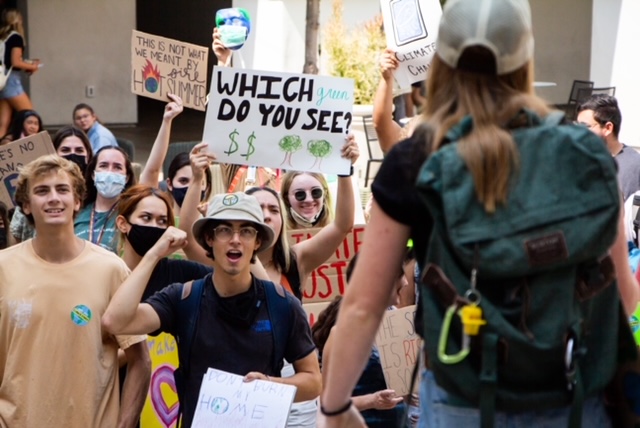Students are disappointed in lack of climate action taken following protest
The Climate Strike protest in the fall 2021 semester brought many students together who demanded change from the university. So far, they have been disappointed in the university’s efforts.
San Diego State’s second student-led climate protest last fall of 2021 was sparked by the university’s stagnant progress on student demands from the first protest in August 2019.
Eight months after the second protest, what progress has the university made on the Climate Justice Strike Organization’s demands?
Major demands the student-led organization advocated for initially included reaching carbon neutrality by 2030 for all of SDSU, creating a Chief Sustainability Officer position in President Adela de la Torre’s office and ensuring the SDSU Mission Valley campus will be carbon neutral.
A former full-time SDSU employee (who wishes to remain anonymous to keep his current job) said he quit after six years because of harassment and bullying from the administration as he continued to advocate for sustainability changes. He said those with the power to enact substantial change at SDSU continually gave him excuses about the department’s inadequate funding.
The COVID-19 pandemic has contributed to progress being stalled, but that is not the only reason, Associated Students Board of Directors member Simran Jain said.
“We just feel like there’s a lack of pressure because the university doesn’t really respect what student voice is,” the former A.S. Green Love Commissioner Jain said. “For at least the last five years, for sure, we have been making the exact same demands and there’s just been a lack of accountability.”
Co-chair of the A.S. Green Love Gardening Committee Eva Huber said the university also says lack of funding is a huge reason for the stagnant progress, but she along with other students refuse to accept that answer.
“If SDSU actually does care about sustainability in the future, then they don’t have a choice but to invest in it,” Huber said. “It can’t be a conversation of ‘oh, we don’t have the money.’ It needs to be a conversation of ‘where are we getting this money?’ because these changes need to happen.”
Jain also said how only those in Green Love and other sustainability organizations on campus are aware of the university’s lack of progress.
Climate Justice Strike Organization leader Gener Abdon said President Adela de la Torre’s email letter response to the organization after the September 2021 strike was unsatisfactory for students.
“The way they sent the letter to us was so patronizing,” the former senate sustainability co-chair Abdon said. “They act as if we didn’t know what we were talking about.”
The university said, in regards to the first demand, that consultants who could provide cost estimates and plans for the 2030 deadline were selected late last fall. Their work began this past February, and they presented their findings yesterday, April 19 to get community feedback.
Regarding the second demand, the new Office of Energy & Sustainability was established on Oct. 1, 2021, with Glen Brandenburg and Dave Weil serving as interim co-directors. The university said they’re actively identifying candidates for consideration and they plan to have an OE&S director on board within the next six to eight weeks.
A Carbon Neutrality Feasibility Study – which started in summer of 2021 – encompasses CJSO’s demands one and three by researching and recommending ways to make the main campus and Mission Valley campus completely carbon neutral, according to the university.
“It’s always about ‘studies, studies’ but there’s no action to actually help improve on these climate issues,” Abdon said.
Many students in A.S., CJSO and the sustainability department said the university’s efforts are for display.
“They’re just taught the buzzwords like ‘LEED certification’ and ‘composting,’” Jain said. “I do think it’s very performative and when you’re in the sustainability movement at San Diego State, it’s frustrating.”
Jain also referenced how the university tried to use sustainability as a way to get a student-funded technology fee passed last semester when, in reality, the fee proposal was about 66% for new technology while only 34% focused on sustainability.
Forums for the technology and sustainability fee were inconsistent and confusing for the students who attended. Jain said the university used students’ passionate investment in climate crisis solutions to try and get a technology fee passed.
“Even with the tech. and sustainability fee, it wasn’t a complete solution (to our climate demands),” Jain said. “We were really mad that they put our climate strike into the presentation for the sustainability and tech fee because we wanted those demands to be funded by the university and not put it on students.”





